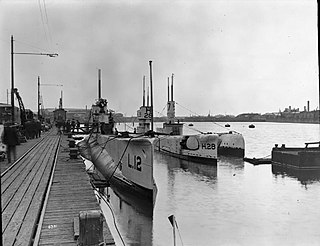
HMS L23 was a L-class submarine built for the Royal Navy during World War I. The boat survived the war and was sold for scrap in 1931.

HMS L4 was a L-class submarine built for the Royal Navy during World War I. The boat survived the war and was sold for scrap in 1934.

HMS L5 was a L-class submarine built for the Royal Navy during World War I. The boat survived the war and was sold for scrap in 1931.
HMS L7 was a L-class submarine built for the Royal Navy during World War I. The boat survived the war and was sold for scrap in 1930.

HMS L8 was a L-class submarine built for the Royal Navy during World War I. The boat survived the war and was sold for scrap in 1930.

HMS L52 was a late-model L-class submarine built for the Royal Navy during the First World War. The boat was not completed before the end of the war and was sold for scrap in 1935.
HMS L54 was a late-model L-class submarine built for the Royal Navy during the First World War. The boat was not completed before the end of the war and was sold for scrap in 1939.
HMS L56 was a late-model L-class submarine built for the Royal Navy during the First World War. The boat was not completed before the end of the war and was sold for scrap in 1938.
HMS L69 was a late-model L-class submarine built for the Royal Navy during the First World War. The boat was not completed before the end of the war and was sold for scrap in 1939.
HMS L71 was a late-model L-class submarine built for the Royal Navy during the First World War. The boat was not completed before the end of the war and was sold for scrap in 1938.

HMS L9 was an L-class submarine built for the Royal Navy during World War I. The boat survived the war and was sold for scrap in 1927.
HMS L11 was a L-class submarine built for the Royal Navy during World War I. She was one of five boats in the class to be fitted as a minelayer. The boat survived the war and was sold for scrap in 1932.

HMS L12 was a L-class submarine built for the Royal Navy during World War I. She was one of five boats in the class to be fitted as a minelayer. The boat survived the war and was sold for scrap in 1932.
HMS L14 was a L-class submarine built for the Royal Navy during World War I. She was one of five boats in the class to be fitted as a minelayer. The boat survived the war and was sold for scrap in 1934.

HMS L15 was a L-class submarine built for the Royal Navy during World War I. The boat survived the war and was sold for scrap in 1932.
HMS L16 was a L-class submarine built for the Royal Navy during World War I. The boat survived the war and was sold for scrap in 1934.

HMS L9 was a L-class submarine built for the Royal Navy during World War I. The boat was completed after the war and was sold for scrap in 1936.
HMS L19 was a L-class submarine built for the Royal Navy during World War I. The boat was not completed before the end of the war and was sold for scrap in 1937.

HMS L20 was a L-class submarine built for the Royal Navy during World War I. The boat was not completed before the end of the war and was sold for scrap in 1935.
HMS L25 was a L-class submarine built for the Royal Navy during World War I. She was one of five boats in the class to be fitted as a minelayer. The boat survived the war and was sold for scrap in 1935.










